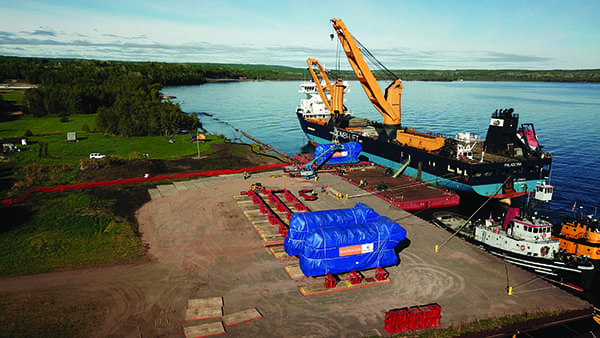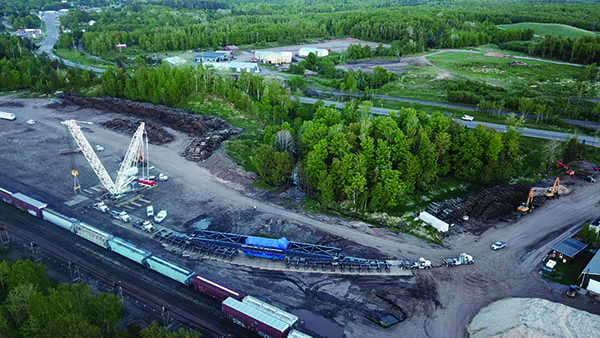Heavy Hauling: Moving 300-Ton Gas Engines from Europe to Michigan
Credit to Author: POWER| Date: Tue, 03 Sep 2019 04:00:00 +0000
Two new power plants in Michigan’s Upper Peninsula (U.P.) came online earlier this year, supplying power for customers of Upper Michigan Energy Resources Corp. (UMERC), a subsidiary of WEC Energy Group. WEC funded the entire $275 million project, which included the 126-MW F.D. Kuester Generating Station in Marquette County, and the 54-MW A.J. Mihm Generating Station in Baraga County.
Planning for the new power plants did not just revolve around the construction sites, however. Months of preparation went into getting the Wärtsilä engines that power the plants from their manufacturing site in Europe to their final destination in the U.P.
Both plants are powered by 18-MW, natural gas-fired Wärtsilä 18V50SG reciprocating internal combustion engines (RICEs)—seven engines at Kuester and three at Mihm. The advanced RICE technology was chosen because each engine can be separately dispatched, providing enhanced power quality and grid stability, a characteristic of particular importance in the U.P. The generating stations replaced capacity provided by the coal-fueled Presque Isle Power Plant, which WEC Energy Group retired earlier this year.
Burns & McDonnell was selected as the engineering, procurement, and construction (EPC) contractor for the two plants in late 2017. “We have designed and built many of the utility-scale reciprocating engine projects in the country,” said Rick Halil, president of the Energy Group at Burns & McDonnell. “The generating stations are demonstrating how flexible, fast-start, low-cost gas-fired generation resources can improve resiliency and power factors on the regional grid.”
 |
1. Wärtsilä engines destined for two power plants in Michigan are offloaded from the general cargo ship Palabora at the port at L’Anse, Michigan, on Keweenaw Bay on Lake Superior after traveling from Italy to the U.S. Courtesy: Martin Bencher Group |
Construction began in February 2018, and the two plants reached commercial operation on March 31 of this year. A key part of the project’s construction timeline was moving the large Wärtsilä engines from their manufacturing plant in Finland, to the loading port at Trieste, Italy, to the discharge port at L’Anse, Michigan (Figure 1), on Keweenaw Bay on Lake Superior, then overland to their final destination at the power plants.
Martin Bencher, a freight transport company headquartered in Denmark, moved the 10 engines from Europe to the two project sites in North America. Each engine weighs about 300 tons, and measures 14 x 4 x 6 meters. Martin Bencher said it took more than 12 months to get U.S. Customs approval for the ship and its cargo, and the company also sought approval from the U.S. Coast Guard. Before the operation, surveys of the bottom of the area near the Michigan port were done, and due to shallow water at the site, a mooring arrangement with spacer barges was necessary to unload the engines successfully.
 |
2. One of the Wärtsilä engines is shown after being loaded onto a specially designed 400-foot, heavy-haul trailer for final transport to the Kuester Generating Station, a new Upper Michigan Energy Resources power plant in the Upper Peninsula of Michigan. Courtesy: Martin Bencher Group |
Martin Bencher said the three engines in use at the Mihm plant were transported from L’Anse on a 20-axle hydraulic trailer. The seven engines destined for the Kuester plant were transported on a specially configured girder beam trailer (Figure 2) operated by Perkins STC (Specialized Transportation Contracting), a company headquartered in Northfield, Minnesota.
“Multiple route surveys, feasibility studies, permitting authorities, third-party support teams, and government entities were involved in the success of this move,” Perkins says on its website.
Perkins’ 400-ton trailer, what it calls its “Road Train,” is configured as a 48-axle, dual-lane loading suspension beam. It includes 13 flatbeds, both legal and oversize trailers. The entire configured trailer was 391 feet long, 22 feet wide, and 19 feet high. Perkins said the gross vehicle weight was 1.3 million pounds.
The move from L’Anse to the Kuester plant in Negaunee, Michigan, covered 61 miles and took three and a half weeks. It was made at night to minimize traffic disruptions. Vic’s Crane & Rigging of Rosemount, Minnesota, provided all crane and rigging support for the project.
Perkins submitted a traffic management plan to local officials prior to the move, and contracted with the Michigan State Police to help escort the transport vehicles and control traffic. The project’s manager, Rob McGhie, provided updates and information about the move at meetings of the county planning commission.
“The job itself took about 250 man-days with 10 Perkins team members working for three and a half weeks straight with upwards of an additional 100 days spent running route surveys, meeting with roadway officials and buttoning up any surprises that could interfere with the success of the project,” Perkins says on its website. “The whole project was a year and a half in the making with four months focused on getting the approvals, third party support, and trained professionals we needed.”
—Darrell Proctor is a POWER associate editor (@DarrellProctor1, @POWERmagazine).
The post Heavy Hauling: Moving 300-Ton Gas Engines from Europe to Michigan appeared first on POWER Magazine.